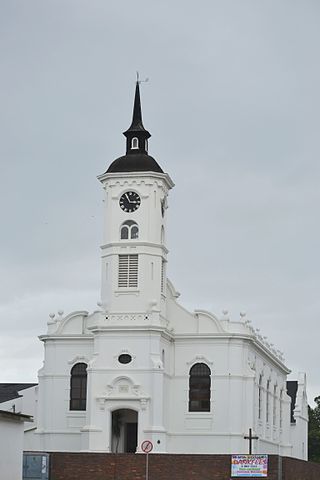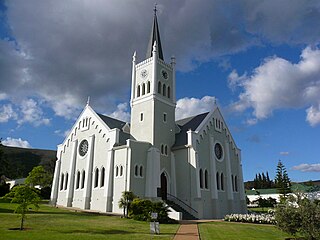First pastor
The first official pastor of the Potchefstroom NGK, however, was proponent J.P. Jooste, appointed in 1868 and serving until 1881, during which time a new church was built to replace the old NHK one. By 1889, Rev. H.J.L. du Toit and Rev. C.D. du Toit were NGK and NHK ministers respectively. The Rev. H.J.L. du Toit, who played a major role in the merger of the two denominations in 1889, left for Lichtenburg once Rev. M.L. Fick began serving as curate and later pastor of the united congregation. The Rev. C.D. du Toit, however, joined the once more schismatic NHK almost immediately, depriving the NGK of all the hard-won gains of the previous years including Rev. Jooste’s church. On February 3, 1894, Rev. Fick’s NHK saw its current church cornerstone laid by State President of the South African Republic Paul Kruger. It was built by architect Richard Wocke.
Along with Kruger, who married in Potchefstroom, Voortrekker leader Andries Pretorius baptized his children there. Among later pastors of the congregation were Drs. Beyers Naudé and Nico Smith, both prominent opponents of apartheid.
Building in ruins
A fire almost razed the building to the ground on July 5, 2007. Restoration work took three years, but the 1894 building re-opened with a witness service on Sunday, November 7, 2010. Former minister Adriaan Vlok gave the keynote, though organ builder Jan Elsenaar was still restoring the organ, which was finished in August 2011. The organ had first been used in Birmingham, United Kingdom in 1897, but was removed and sold to a Dutch organ builder many years later, from whence Elsenaar obtained it and bought it for the congregation. By the first service in three years, the restoration bill had reached R7.4 million, paid for with insurance, bequests, and other donations.
The Reformed Churches in Namibia is a confessional Reformed church in Namibia. Reformed people come from Angola to Namibia in 1929. The Dorslandtrekkers were mostly Reformed people who had settled in Angola but later moved to Namibia. The Dorslandtrekkers were originally from Transvaal, South Africa, and migrated northwestward starting in 1874 in two large and one smaller group, starting the Humpata Reformed Church under the Rev. Jan Lion Cachet. Later in 1930 3 congregations were established. More farmers came and the church grew. Missionary work was started in 1969 under the Bushmans of the Gobabis region, Botswana. It has 2,757 members and 14 congregations, and adheres to the Apostles Creed, Nicene Creed, Heidelberg Catechism, Belgic Confession and the Canons of Dort.There's no women ordination. Official languages are Afrikaans, Bushman, Gobabis-Kung.
The Dutch Reformed Church Windhoek or NGK Windhoek is the oldest congregation of the Dutch Reformed Church in South Africa (NGK) in Windhoek the capital of Namibia.
The Gobabis Reformed Church is the oldest congregation of the Reformed Churches in South Africa (GKSA) in Gobabis in eastern Namibia. At the end of 2015, according to a poll of 300, it was the second-largest traditional Reformed Church congregation in the country.
The Rev. Matthys Michielse du Toit was a Christian pastor in the Dutch Reformed Church in South Africa (NGK).
The Gobabis Reformed Church is a congregation of the Dutch Reformed Church in South Africa (NGK) in Gobabis in eastern Namibia. In 1961, the Gobabis-South daughter congregation was founded, which was reincorporated into the mother church on October 21, 2012, making Gobabis the seventh city in Namibia to have two NGK congregations.
The Keetmanshoop Reformed Church is a congregation of the Dutch Reformed Church in South Africa (NGK) in southern Namibia. It is the third oldest NGK congregation in the country after Mariental and Otjiwarongo. Up until the founding of the Keetmanshoop congregation, the entire area known then as South West Africa (SWA) was divided between the two mother churches.
The Mariental Reformed Church is the oldest congregation of the Dutch Reformed Church in South Africa (NGK) in Namibia and was founded in 1898 as the Gibeon Reformed Church.
The Omaruru Reformed Church is a congregation of the Dutch Reformed Church in South Africa (NGK) in the town of Omaruru, Namibia. It is the oldest daughter church of the Otjiwarongo Reformed Church (NGK), from whence all the NGK congregations north and west of Windhoek, capital of Namibia, directly or indirectly descend. Omaruru separated from Otjiwarongo on March 1, 1941, and services were held in Omaruru, Karibib, Usakos, Swakopmund, Walvis Bay, and Kalkfeld. Still large and difficult to serve, the Omaruru congregation let the Usakos Reformed Church (NGK) go in 1946.
The Usakos Reformed Church is a congregation of the Dutch Reformed Church in South Africa (NGK) in Namibia, established in 1946 and serving as the mother church to all five congregations of the Namibian coast, except for the Lüderitz Reformed Church (NGK).
The Brixton Reformed Church was a congregation of the Dutch Reformed Church in South Africa (NGK) in the western suburbs of Johannesburg, South Africa, which was absorbed along with the Johannesburg West Reformed Church (NGK) in 1993 into the new Vergesig Reformed Church. Brixton's centrally located building continues to serve the merged congregation, which has since acquired the Langlaagte Reformed Church as well as the Crosby West Reformed Church. Around 1985, the Cottesloe Reformed Church was also absorbed into the original Brixton congregation. Around 2014, Vergesig changed its name to Brixton Church.
The Johannesburg Reformed Church was the first congregation of the Dutch Reformed Church in South Africa (NGK) to be founded in Johannesburg on August 14, 1887. All the congregations on the Witwatersrand stem from it, but by the 2010s, the NGK yearbook recorded only 90 in its ward which had long ceased to operate independently.
The Johannesburg North Reformed Church/Andrew Murray Congregation is a bilingual congregation of the Dutch Reformed Church in South Africa (NGK) in the Johannesburg suburb of Orchards. It was formed in 1999 by the merger of the NGK congregation and the Andrew Murray Congregation and functions as a church without borders.
The Johannesburg East Reformed Church was a congregation of the Dutch Reformed Church in South Africa (NGK) in the Johannesburg suburb of Doornfontein, just east of downtown. It is also known as the Irene Church after the sobriquet of its second and third churches on 1 Beit Street. Five weeks before its centennial, on June 1, 1997, Johannesburg East was absorbed by the Johannesburg Reformed Church (NGK), from whence it had seceded on July 8, 1897.
The Langlaagte Reformed Church was the 28th congregation of the Dutch Reformed Church in South Africa (NGK) on the Transvaal and the second in Johannesburg after the Johannesburg Reformed Church (NGK) (1887). The congregation is well known as the spiritual home of the Langlaagte orphanage, later named the Abraham Kriel Children’s Home after Rev. Abraham Kriel, who founded it as pastor of Langlaagte.
The Parkhurst Reformed Church was a congregation of the Dutch Reformed Church in South Africa (NGK) that was active from 1944 to 1996 in the Johannesburg suburb of Parkhurst.
The Turffontein Reformed Church was a congregation of the Dutch Reformed Church in South Africa (NGK) in southern Johannesburg, Transvaal. It was founded in 1906 and for years had a large membership, at times exceeding 3,000.
The Bronberg Reformed Church was one of the largest congregations in the Dutch Reformed Church in South Africa (NGK), not only in the Pretoria area but nationwide. After the massive demographic changes of the 1990s in central Pretoria, the Bronberg, Arcadia (which had earlier absorbed Meintjieskop, Burgers Park, and Harmonie congregations were all absorbed by the Pretoria Reformed Church.
The Rustenburg Reformed Church is the oldest congregation of the Reformed Churches in South Africa (GKSA), founded in February 1859 by the denomination’s pioneer, Rev. Dirk Postma.

The Dutch Reformed Church is a place of worship of the Dutch Reformed Church in Alexandria, South Africa.

The Dutch Reformed Church in Barrydale is a congregation of the Dutch Reformed Church centered on the village of Barrydale in the picturesque surroundings of the Langeberg on the R62, 62.5 km south-east of Montagu, 76 km south-west of Ladismith and more or less equidistant ( 45 km) through the Tradouw Pass from Swellendam and Heidelberg. In 2014, the congregation had 49 baptized and 211 professing members. In that year the pastor was Rev. W. J. van Zyl.


